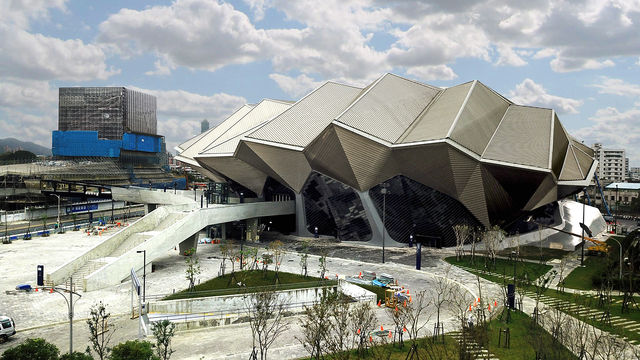Reiser+Umemoto, or RUR Architecture DPC, won an architecture design contest by including bridges in their plans for a music center.
Jesse Reiser and Nanako Umemoto of RUR Architecture will hold a lecture in Perloff Hall on Wednesday discussing their two current architectural projects in Taiwan and teaching students about the process of creating architectural theory. A group of academic jurors from around the world selected the company’s Taipei Pop Music Center design, a project included in the discussion, to be used for the building. Reiser, a professor of architectural design at Princeton University, said the company has been characterized by its experimental design work, but it recently began working on bigger projects such as the music center. RUR Architecture collaborated with music industry officials to design a site that could be used for different performers and listeners alike, Reiser said.
“(The Taipei Pop Music Center) wasn’t just an architectural project, but it was really an urban planning project,” Reiser said. “The ambition was to create a new area in Taipei dedicated to the production and performance of music, and have that integrate with the everyday life of the city.”
[RELATED: Alumna’s architecture integrates aesthetics with practical design]
Reiser said building the music center in Taipei has been a long process since the firm’s plan won the contest and began working. The government and officials in the pop music industry gave instructions to their firm on requirements, such as theater size, that they had to follow during their construction, he said. The original winning theater plans increased in scale to include 2,000 additional seats because of the project’s shift in control from the Taiwanese government to representatives from the pop music industry.
“We actually had to start over. … (Originally) the performance hall had to work both as a music venue, but also could be modified for traveling Broadway-type shows. That was completely eliminated when the music industry took over,” Reiser said. “They had a totally different idea about how the audience should participate or be part of the space of music.”
The design also includes a space that could be used as an urban plaza during the day and create a large, open concert space when closed off at night, Reiser said. The plan allowed the plaza to be used for 24 hours instead of the limited operating hours of a shop or venue that can close during the day, he said.
The way RUR Architecture designed the music center implemented typical architectural elements that exist in Taipei, like bridges and a plaza on the ground below them, Reiser said. But it was also important that the plans included design aspects that could be dedicated to the history of the Taiwanese and Mandarin pop music industry. The “Hall of Fame,” a cube-shaped section of the site, focuses specifically on honoring the industry’s growth in the 1970s with a museum and archive dedicated to the period, Reiser said.
Umemoto, a visiting professor at Washington University in St. Louis, said by involving people who would perform at the center while planning designs, RUR Architecture was able to work more quickly. Artists told them what equipment they would need in each part of the site and what necessary changes were needed to be made to the theater for performance, she said.
“We realized that you can’t mix a Broadway musical kind of theater to pop music center, or classic ballet theater – they are completely different,” Umemoto said. “So this is dedicated to the pop music center, the music and the musicians.”
[RELATED: Architects discuss building around urban environment, natural terrain]
Communication continues to be a large part of the construction process, said Jasmine Lee, who is in charge of coordinating and revising plans for the Taipei Pop Music Center. Speaking with theater consultants from Hong Kong, Taiwan and the United States helped to shape what the complex would look like, Lee said. Even though the site will be used for pop music, each performer will use the space differently, she said. RUR Architecture had to plan for the differences accordingly, creating a space in the main hall that is more established for bigger crowds, while smaller indoor venues and open theaters will be located on the complex’s south side, Lee said.
“According to the local music industry, it’s not going to be like superstar kind of performances, but more of those growing bands,” Lee said. “And (the performers) attract very different people and they have more experimental ways of performing, so that’s why we try to work with them on that.”
RUR Architecture created a plan for the Taipei Pop Music Center that could be flexible for a range of artists performing there in the future, Reiser said. Including a large outdoor performance space, two different clubs and a pop music museum and archive allowed the plan to avoid becoming too specific to one type of music, he said. The multiple aspects of the site can be used in accordance with whoever is performing or the experience attendees want to have, Reiser said.
“Taiwanese pop is part of a larger constellation of different pop, like K-pop and Japanese pop, they’re all in some way linked,” Reiser said. “And so part of this also was about visual identity – that the center would be striking and would be televised, so that people would recognize Taiwan’s Pop Music Center as being, in a sense, iconic and visible.”



Comments are closed.